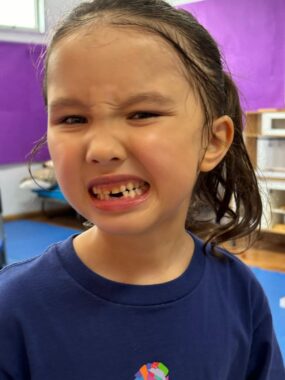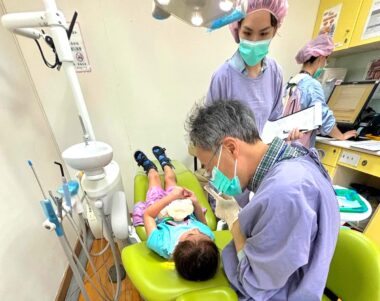Our daughter’s first trip to the dentist was a home run
We were worried she'd have an anxiety attack, but she conquered it like a pro
Written by |

Our daughter, Rylae-Ann, lost her first tooth not too long ago, and boy was it an event. She’d been wiggling that thing for days, proudly announcing to anyone who would listen that her tooth was loose. While she was initially worried about it, we quickly reassured her that it was part of becoming a big girl.
When the tooth finally popped out, Rylae-Ann almost left it in a hotel lobby without telling us. Once we retrieved it, she held it with pride, like a trophy.
What surprised us at the time was that Rylae-Ann, who has aromatic l-amino acid decarboxylase (AADC) deficiency, was displaying little to no anxiety. Although she had gene therapy to treat AADC deficiency nearly five years ago, addressing the symptoms of anxiety remained a goal for her. AADC deficiency is a deadly and debilitating rare disease, so we are incredibly fortunate that this is the only challenge that remains after gene therapy.
For the past year, we’ve been working on helping Rylae-Ann manage her emotions, so it seemed like a tooth falling out would have induced at least a few tears. Instead, the entire experience was a wonderful memory we discuss often.
Time to see the experts
Meanwhile, a second tooth recently came out, with more expected to follow. Rylae-Ann was thrilled and quickly began discussing the great surprise under her pillow that awaited her the following morning. We figured it was time for her to meet the real teeth experts, with their fancy chairs and shiny tools: It was time for her first trip to the dentist.

Rylae-Ann flashes a grin to show off the gap where her second lost tooth had been. (Photo by Richard E. Poulin III)
But visiting hospitals had always been significantly challenging, from the moment we pulled up to the curb to long after we left. Rylae-Ann would fight and cry, and it took a lot of patience and hard work to complete such a trip.
My wife, Judy, and I believe that pediatric medical traumatic stress was a significant factor in Rylae-Ann’s meltdowns. The first few years of her life were spent in the hospital. When she turned 3 months old and started exhibiting oculogyric crises — a type of acute dystonia in which the eyes deviate upward — we were always in and out of hospitals, subjecting her to a battery of tests while trying to figure out what was wrong.
If we weren’t visiting hospitals for tests and consultations, we were there for an emergency. The cause of her hospital admissions ranged from aspiration and pneumonia to a dislocated hip. A 12-hour brain surgery for gene therapy finally reduced our hospital trips to routine checkups.
Rylae-Ann’s anxiety tended to worsen such situations. However, by using drama therapy and a hefty dose of creativity, these trips to the hospital eventually became a tear-free experience.
A different approach
With teeth now falling out, it seemed like the time had finally arrived for Rylae-Ann to have her first dental appointment. The first one is recommended by 12 months of age or within six months after the first tooth pokes out.
That time had long passed for Rylae-Ann, who is now 6 years old. We couldn’t wait any longer. So we decided to book an appointment but weren’t sure about the next steps.
A few months ago, I would’ve said we should start role-playing and acting out the visit. But it somehow felt like that wasn’t necessary. She was already good with hospitals, and a dental clinic would have a similar feel to it. Also, she looks forward to brushing her teeth every day.
Judy and I decided to approach it with little fanfare or discussion. In the morning, we explained that we would visit a doctor who would examine her teeth — or lack thereof. The trust paid off.
Checking off another milestone
The dentist called us in, and Rylae-Ann marched into the exam room like she owned the place. She climbed into the big chair, her feet barely touching the edge, and looked around wide-eyed, taking in all the shiny tools and the bright light above her.

A dentist examines Rylae-Ann and explains all of the dental tools during her first trip to the dentist’s office. (Photo by Richard E. Poulin III)
The dentist was a cheerful older man who was excited that it was her first dental appointment. During the checkup, he showed Rylae-Ann all the different tools and explained how they help people. Even afterward, she wanted to continue exploring and learning.
To help get Rylae-Ann out and his next customer in, the dentist gave her a balloon animal he made himself; it was pretty impressive. As we left the office, Rylae-Ann turned to us and said that she loved the dentist. I’m sure the balloon animal won her over, but there was no denying that it was a complete 180-degree turnaround from a few years ago.
Judy and I smiled the whole way to the car, relieved that the appointment had gone so well and amused by our daughter’s courage and ability to turn the simplest experience into an adventure.
With a shiny new gap in her smile and a story to tell, Rylae-Ann had conquered her first trip to the dentist, leaving us wondering what our next adventure would be.
Note: AADC News is strictly a news and information website about the disease. It does not provide medical advice, diagnosis, or treatment. This content is not intended to be a substitute for professional medical advice, diagnosis, or treatment. Always seek the advice of your physician or other qualified health provider with any questions you may have regarding a medical condition. Never disregard professional medical advice or delay in seeking it because of something you have read on this website. The opinions expressed in this column are not those of AADC News or its parent company, Bionews, and are intended to spark discussion about issues pertaining to aromatic l-amino acid decarboxylase deficiency.






Leave a comment
Fill in the required fields to post. Your email address will not be published.